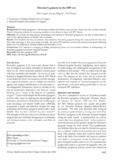| dc.contributor.author | Ngugi, P | |
| dc.contributor.author | Magoha, G | |
| dc.contributor.author | Nyaga, P | |
| dc.date.accessioned | 2015-04-09T08:30:28Z | |
| dc.date.available | 2015-04-09T08:30:28Z | |
| dc.date.issued | 2015 | |
| dc.identifier.citation | Afr Health Sci. 2014 Dec;14(4):1063-8. | en_US |
| dc.identifier.uri | http://www.ncbi.nlm.nih.gov/pubmed/25834518 | |
| dc.identifier.uri | http://hdl.handle.net/11295/81960 | |
| dc.description.abstract | Background
Fournier's gangrene is a devastating condition that affects mostly patients whose immunity has been reduced. There is increasing evidence for increasing incidence of the disease in those with HIV disease.
Objective
To evaluate the presentation, bacteriology and outcome of Fournier's gangrene in our area in recent times in view of the high prevalence in Nairobi and its environs.
Results
One hundred and forty six patients were treated for Fournier's gangrene during the study period; all were male. They had a mean age of 38.6 years (range 2 months – 86 years). HIV infection was the most common associated underlying illness (16.4 %), followed by diabetes mellitus and alcoholism (11%).
Conclusions
HIV infection is emerging as leading predisposing factor and has overtaken diabetes in predisposing for Fournier's gangrene in Kenyatta National Hospital | en_US |
| dc.language.iso | en | en_US |
| dc.publisher | University of Nairobi | en_US |
| dc.subject | Fournier's gangrene, HIV | en_US |
| dc.title | Fournier's ganrene in the HIV era. | en_US |
| dc.type | Article | en_US |
| dc.type.material | en_US | en_US |

